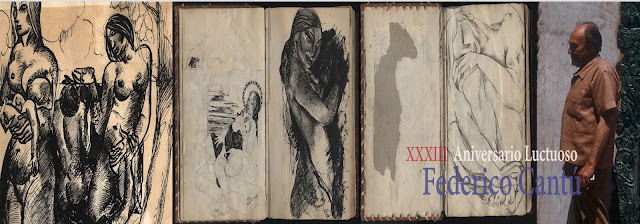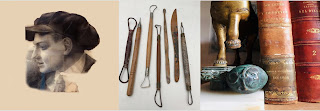The Dorian Sketchbook of Federico Cantú: Scenes from his Private Life
Part I: “Dorian”
1928
After living in Paris since 1924, Federico Cantú Garza – at that time a young painter who used the pseudonym "Dorian"- decides to visit Mexico for a short break in the spring of 1928.
After the usual sea voyage, in third class and stopping in Cuba, he finally arrived in Veracruz in May 1928, proceeding by land from the port to Mexico City and arriving exhausted at his house in Calle de San Francisco, Colonia del Valle. In his baggage, made up mainly of clothing, art supplies, books, tools and even a couple of revolvers, the young master treasured Joyce’s Ulysses, Goethe’s Faust, and the well-known work of Oscar Wilde from which he took his artistic name.
His mother, the writer María Luisa Garza, "Loreley", who had been writing a series of novels for an entire decade, was pleased by the set of books that her favorite son decided to bring her in appreciation of her unstinting economic support which had allowed him to pay for his stay in Paris.
Federico could not have imagined that he was arriving at precisely the moment that his mother’s life was about to turn completely around, leading her to leave Mexico. She intended to restart publication of her magazine entitled “Alma Femenina", which she began to publish around 1922 in San Antonio, Texas, prior to accepting an offer from José Vasconcelos to work in Mexico City.
Federico Cantú, "Dorian", intended to spend the summer in Mexico City before returning to France to continue working in his Montparnasse atelier, knowing that he had to choose between obtaining sufficient resources to continue living the bohemian lifestyle of Paris, or else to immediately accompany "Loreley" in her travels in the United States of America. Unexpectedly, a slight but sudden love interest would make him change his plans and decide to spend the summer with his fiancée in California.
His sudden decision was motivated by his mother’s intention to move to the United States and restart publication of “Alma Femenina", and especially because, just a few hours after returning to Mexico City, he realized that his mother was being courted by a handsome young essayist, poet and painter by the name of Alfonso Fabila Montes de Oca.
Part II: Los Angeles, California
1928-1929
That summer, Alfonso made an effort to ingratiate himself with the young Federico, publishing a series of his articles in the Mexico City newspapers and introducing him to his younger sister, Luz Fabila Montes de Oca.
The triumphs of "Loreley" as part of the cultural project of José de Vasconcelos had already significantly changed the life of this family, which changes were exacerbated by the presence of Alfonso Fabila. For the first time, Federico had to face the reality of his mother’s romantic life, and did not much like the idea. To his dismay, Alfonso naively tried to take on the role of patriarch within the family structure, without realizing that María Luisa and Federico understood life from the perspective of the highest values of liberty and equality. Of course these principles were very different from those in force in Mexico at that time, especially for someone like Alfonso, who came from a family of nineteen siblings, whose hometown was Amanalco in the State of Mexico, and who acted as guardian of his younger sister. It will be remembered that both "Loreley" and "Dorian" had lived in the United States, and the latter had already had the experience of living in France.
Although Federico Cantú did not approve of his mother’s relationship with Alfonso Fabila, he was certainly interested in meeting and getting to know his sister Luz, with whom he began a relationship almost immediately.
As an aside, one may see throughout Cantú’s work an extensive and intentional description and depiction of weapons, given that he was an avid collector of different types of rifles, pistols and revolvers. His collection was such that four decades later these weapons may be seen as part of the decoration of the chimney of his house. Years later and referring to Fabila, Cantú recalled that “No matter how many times I insisted that he return that beautiful pistol I brought back from Paris, Alfonso never gave it back.”
In June 1928, with the decision to move to California, Federico and Luz saw the opportunity to join in the plans of "Loreley", and decided to formalize their love, signing a religious letter which committed them before God, in the middle of the Cristero War. That summer, both of them crossed the border and arrived in Los Angeles, without paying much attention to the lack of means which is all too common among artists.
"Loreley’s" magazine was successfully restarted and Federico began to exhibit his work. The young master survived by translating newspaper articles and started becoming known for paintings done on commission, soon being mentioned in newspapers of the time as promising visual artist who quickly established relations with the most important museum directors in the United States.
Interviews and publications arose at the same time as art shows. Arthur Miller, José Vasconcelos, Luis Cardoza y Aragón and Edward Doro, among others, wrote of the artist’s triumphs.
Birth of Ícaro
This promising year would rapidly change the destiny and vision of the young artist. Federico and Luz were married in a civil ceremony in Los Angeles. He also received a commission to paint a mural in Pasadena and began a series of works referencing the work of Goethe, Lord Byron and of course Oscar Wilde, with evident allusions to the theme of Dorian Grey.
Cantú so identified with these works that when his son was born on May 1 of that same year, he decided together with his wife to register the birth of his son under the name of Ícaro (Euferion), which was the name given by Johann Wolfgang von Goethe to Byron in his work, referring to him as the disobedient son.
As Federico himself tells in his letter of April 29 to Alfonso Fabila, at this time the painter was immersed in painting the canvas entitled Homenaje a Lord Byron- Cantú Y de Teresa Collection- precisely that in which he included the figure of Ícaro.
Luz Fabila herself said, in a letter to her brother Alfonso and in her memoirs, that at that time Federico signed a large part of his work with the pseudonym "Dorian", in reference to the mythical figure of Dorian Grey. Our knowledge that he used this signature comes from these writings, as the pictorial work dating from this period in Cantú’s life has almost completely disappeared.
Federico Cantú admired the sketchbooks in fashion at that time among the masters of Montparnasse. Thus, he began such a book in the summer of 1929, without realizing that this book, bound in leather by his wife Luz, would serve as the preamble to future presentations in an upcoming stay in Paris.
The sudden crash of 1929 would change the destiny of an entire generation of Americans, as well as ruining the dreams of many immigrants, including those of Federico Cantú and Luz Fabila.
The crash itself did not prevent a series of shows and sales of Federico’s work, but his mother "Loreley’s" magazine suffered a serious setback and ceased publication in December of the same year.
Expo Monterrey NL
Carpeta Dorian
2018



No hay comentarios:
Publicar un comentario